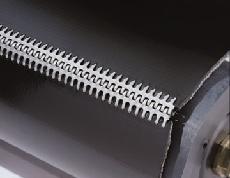Sidewall Cleat conveyor belt
A. Bucket bolts pull through belt or belt tears at bolt hole:
1. Bucket bolts not tight. Inspect frequently and tighten as required.
2. Inadequate belt construction for holding bolts. Replace belt with one properly designed.
3. Obstruction in casing or insufficient clearance. Check terminal pulleys for proper alignment to insure straight-running belt. Redesign elevator if necessary.
4. Jammed boot. Install controlled feed to help eliminate jams and turbulence in boot.
5. Pulleys too small or incorrect belt splice strains bolts as belt flexes. Install larger head pulley if possible. Use correct splice. Check belt construction for possibility of thinner belt.
6. Change in service conditions. Lump size or weight in buckets increased from original design. For larger lumps, change feed or boot design to accommodate. For heavier material, change belt construction to proper selection.
B. Belt cover wears excessively on bucket (top) side:
1. Bucket not completely discharging material. Material downlegging and becoming trapped between bucket and belt cover. Change speed to improve discharging. Adjust discharge spout bottom plate more closely to bucket lip.
2. Fine abrasive material between bucket and belt cover. Use rubber or leather washers or pads between bucket and belt cover.
3. Improper belt quality or cover gauge too tight. Increase cover thickness and upgrade belt with replacement.
C. Belt covers wear excessively on pulley (bottom) side:
1. Abrasive material dropping between belt and boot pulley. Use slotted or self-cleaning type of pulley.
2. Belt slips at head pulley. Lag head pulley. If necessary, increase tension at terminal pulley.
3. Cover gauge too light or improper belt quality. Increase cover thickness or upgrade belt on replacement.
D. Belt carcass breaks:
1. Lump material dropping between belt and pulley. Use slotted or self-cleaning pulley.
2. Operating tension exceeds maximum allowable working rating of belt. Calculate belt tension and install new belt with correct strength design.
E. Cover separates from carcass:
1. Service condition too severe. Improve cover adhesion by using breaker between carcass and cover.
2. Temperature problems. Check operating conditions to make certain that belt temperature allowable is not exceeded.



